How is the CRM application built on the nAxiom low-code platform?
Low-code is a technology that has significantly simplified the way software is created, making it more accessible to a wider range of users. It is no wonder that it has become a permanent part of the software house offering, and business clients are increasingly reaching for this solution.
Why? Low-code allows you to create applications quickly and efficiently, without the need for advanced coding. Platforms such as nAxiom allow you to build business applications in an agile and efficient way. In this article, we will take a look at how a CRM application is built on the nAxiom low-code platform, analyzing its construction - step by step.
The application implementation process has never been so easy
Low-code technology is becoming a key element in the digitalization of companies today, enabling the quick and effective creation and implementation of business applications. Traditional methods have so far required advanced programming knowledge and many hours of coding, which was both a time and financial barrier for many companies. Low-code changes this paradigm, offering ready-made components that can be easily adapted to the specific needs of the company. Thanks to this, the application development process becomes more agile, flexible, and often more cost-effective, opening the door to new possibilities for a wider group of users.
Low-code is like building blocks - you build an application from ready-made elements
Low-code is often compared to the process of building from blocks. Applications created in this technology are based on previously prepared components that can be freely combined, adapting to the specific needs of the company. This work model significantly speeds up the software development process and also allows you to eliminate errors related to application implementation.
One of the greatest advantages of low-code technology is the ability to create applications using designer tools that use visual programming methods. Thanks to Drag&Drop interfaces, users can easily create and modify forms, tables, reports, or dashboards. This does not require advanced programming knowledge, which makes the application building process more intuitive and accessible even for people who have no experience in coding.
8 Reasons to Implement a Low-Code CRM App
A CRM app built on a low-code platform like nAxiom is a customer relationship management tool that is designed to be easy to create, modify, and customize based on your business needs. The benefits of implementing such a system are huge and worth taking a closer look at.
1. Reduced implementation time
One of the key advantages of a CRM application built on a low-code platform is a significant reduction in implementation time. Traditional software development methods can take months or even years, engaging teams of programmers in complex coding processes. Thanks to low-code, applications can be ready for use in a few weeks. Ready-made components that can be easily customized to the specific needs of the company speed up the entire process, enabling faster implementation and a faster return on investment.
2. Reduced IT costs
Implementing a CRM application built on a low-code platform also saves IT costs. Traditional solutions often require hiring highly skilled programmers and investing in expensive technological resources. Low-code eliminates these barriers, allowing applications to be built without the need for advanced coding. Thanks to this, companies can significantly reduce their IT expenses, while modernizing their systems and adapting them to new market challenges.
3. Quick response to changing market needs
The business market is dynamic, and the needs of companies can change from day to day. A CRM application built on a low-code platform allows for quick response to these changes. Thanks to flexible tools for modifying applications, companies can adapt their systems to current market requirements, introducing new functions or changing existing processes in real time. This gives companies a competitive advantage by being able to quickly adapt to new conditions.
4. Automation and optimization of business processes
A CRM application based on low-code is not only a tool for managing customer relationships, but also a platform for automating and optimizing business processes. Thanks to built-in automation functions, companies can reduce the time and resources needed to perform repetitive tasks, which allows them to focus on more strategic activities. Automatic generation of reports, management of marketing campaigns, or integration with other systems are just some of the possibilities offered by low-code in terms of process optimization.
5. Easy integration with other systems
Another significant advantage of a CRM application built on a low-code platform is the ability to easily integrate with other systems used in the company. nAxiom enables the creation of a coherent technological environment in which all applications work harmoniously, exchanging data and cooperating in real time. Thanks to this, companies can better manage their resources, avoiding problems related to system incompatibility.
6. Accessibility for people outside the IT department
Low-code opens the door to creating business applications not only for programmers, but also for people outside the IT department. Thanks to intuitive tools such as Drag&Drop interfaces, employees of other departments can independently create and modify applications according to the needs of their work. This significantly lowers the entry barrier and allows for faster innovation in the company, without the need to involve the IT department in every process.
7. Agility and flexibility in operation
The nAxiom platform enables companies to take an agile and flexible approach to creating and implementing CRM applications. Even at the early design stage, it is possible to create a working prototype that can be quickly tested and adapted to real business needs. This work model allows for early verification of functionality, which in turn minimizes investment risk and allows for quick implementation of corrections.
8. Flexibility in various industries
One of the greatest advantages of a CRM application built on a low-code platform is its versatility and flexibility, which allows for use in various industries. Regardless of whether you operate in the financial, trade, manufacturing or service sector, low-code allows you to adapt the application to the specific requirements and processes characteristic of your industry. Thanks to this, you can quickly implement changes and optimize activities, adapting the application to changing market realities.

Discover a new approach to digitalization implemented using a flexible low-code platform that provides organizations with everything they need in such a rapidly changing reality
Building the nAxion application – step by step
You already know the many advantages of implementing a CRM application on a low-code platform. Now it's time to take a closer look at it in practice and see what building such an application looks like in reality.
The CRM application on the nAxiom platform was designed with comprehensive support for the sales department in mind. Its main functionalities include not only managing information about contractors, but also effectively monitoring sales opportunities, organizing interactions with customers, and optimizing sales processes. Thanks to this tool, sales teams can better manage their activities, track progress in negotiations, and quickly respond to customer needs.
Key functionalities of the CRM application on the nAxiom platform
The CRM application on the nAxiom platform was designed to provide comprehensive support for sales activities and customer relationship management. Below we present the key functionalities that make this platform an extremely effective business tool.
Collecting, storing and organizing information about contractors
The application allows you to maintain a central register of contractors, where you can collect all the necessary contact details, interaction history and information about business relationships.
Event and customer interaction registration
nAxiom allows for precise monitoring and documentation of all customer contacts, such as meetings, phone calls or email correspondence.
Sales opportunity registration and management
nAxiom also enables the assessment of sales opportunities at every stage of the process, from identification to finalization.
Marketing campaign creation and management
The tool allows for defining, implementing and monitoring marketing campaigns, which helps in effectively reaching the right customer segments.
Data reporting and presentation
The application offers extensive reporting options, enabling the generation of analyses and presentation of sales results on clear dashboards.
CRM Application – Salesperson View
A salesperson using the CRM application has access to an intuitive dashboard that contains all current tasks.
Dashboard with current tasks
This view shows tasks scheduled for a given day and those that are overdue. Tasks are color-coded, which makes it easy to quickly recognize the status – completed tasks are marked in orange, and those to be completed are marked in green.
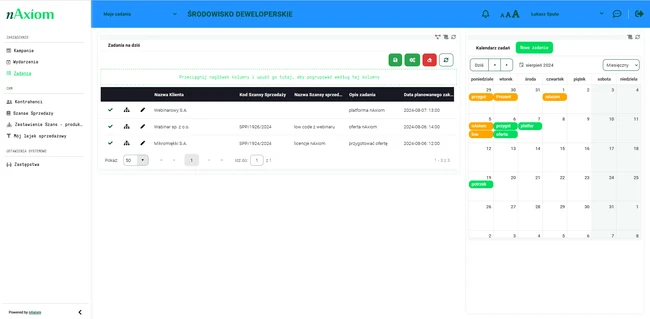
Application Menu - Sales Opportunities
A salesperson can easily create new sales opportunities, assign them to products, and track their progress through different stages of the sales funnel. The sales opportunities per product view allows you to evaluate products with the highest potential.
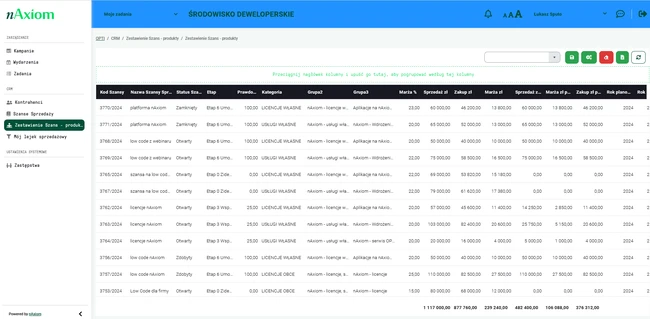
Customer File
A customer file is a central place where all key information about a given customer or business partner is collected. The file contains the customer's contact details, such as company name, address, phone number, email address, and other important details that facilitate relationship management.
In addition, this tab allows access to the full history of interactions with the customer, including records of meetings, phone calls, email correspondence, and any other contacts. This allows the user to quickly track the course of the relationship with a given customer. The customer file also contains information about current and past sales opportunities related to it.
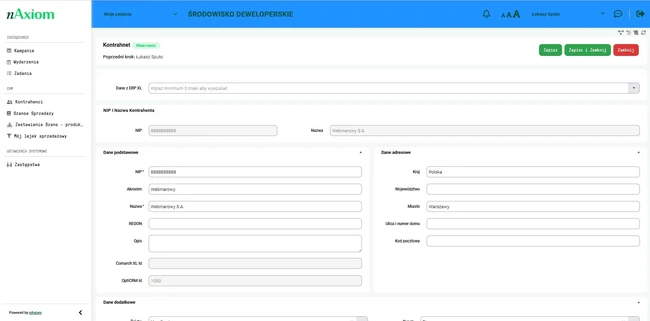
Sales campaign
A sales campaign in the CRM application on the nAxiom platform is an organized marketing activity that aims to reach a specific group of customers and promote the company's products or services. The application allows users to create, manage, and monitor sales campaigns in an integrated and effective way.
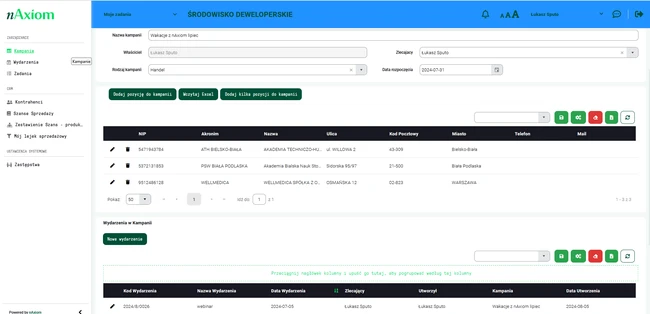
CRM Application – Sales Manager View
The Sales Manager View is more advanced than the Sales Manager View, allowing you to manage your team and monitor your department's performance. The Department Task View allows you to monitor your team's work, including viewing current tasks and their status.
Department Report
Allows you to analyze your team's performance, compare sales opportunities per product, and filter and sort data. Importantly, all lists can be exported to Excel.
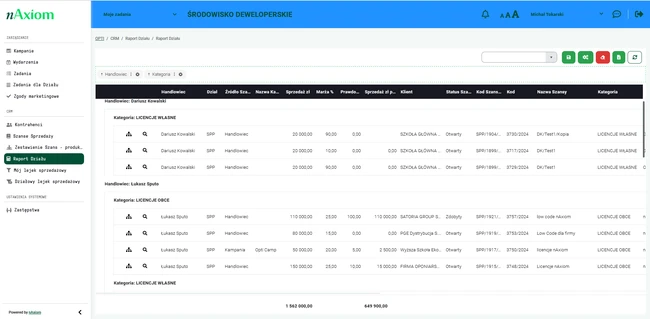
Departmental Sales Funnel
Presents sales opportunities for the entire team, which allows for a reliable assessment of the effectiveness of sales activities.
Why implement CRM on a low-code platform today?
If you want to quickly implement a functional CRM system, don't wait - do it today. Thanks to low-code technology, you can shorten the implementation time, reduce costs and increase the flexibility and efficiency of your activities. The nAxiom platform is an advanced, scalable solution that you can easily adapt to the specific requirements of your company. Use the possibilities offered by nAxiom and accelerate your digital transformation - start acting now!
Tell us your problem and we will suggest how you can solve it.
We take very seriously every question addressed to us. If you tell us what you need, we will discuss together which solutions will best meet your expectations. If you want to learn more about the nAxiom platform, we will tell you and provide you with additional materials. And if you would like to take part in a webinar, we will tell you when the next online meeting will take place and what topics it will cover.
